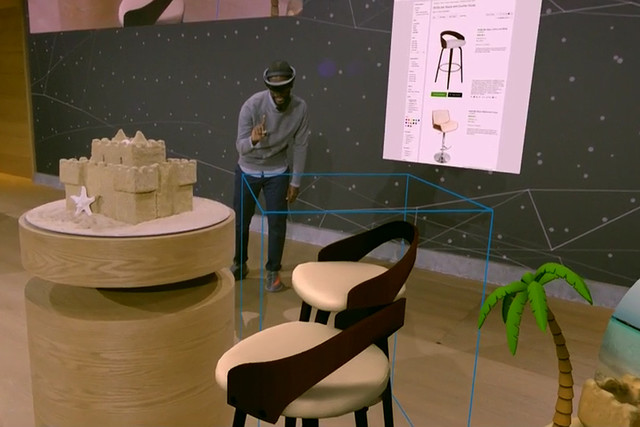Why it matters to you
This will be important to developers for creating augmented reality experiences that can be shared with a general audience.
As we saw 30 minutes into Microsoft’s recent Windows 10 Creators Update press event, the company can display what a HoloLens user sees in real time to a general audience. For instance, Microsoft “experience designer” Taj Reid pulled a holographic chair out of a floating web browser and positioned it on the stage. While he experienced all of this in first-person, the audience could see the same objects in a third-person view though the event’s large displays or via the online broadcast. Now Microsoft wants to bring this “spectator view” to all HoloLens developers.
During October’s press event, Microsoft brought out a special camera that captured Taj Reid’s demo in real time while simultaneously rendering the holograms into the live feed. Microsoft wants developers to create a similar camera by offering documentation based on its camera design, aka the Spectator View Camera. The use cases for this setup include snapping images of HoloLens wearers as they interact with holograms, live demonstrations, and video capture.
More: Developer shows off ‘Final Fantasy XIV’ gameplay on Microsoft’s HoloLens
“Since a HoloLens can only be worn by one person, how do you open the view so everyone can see what that person sees? To solve this problem, we developed Mixed Reality Capture (MRC) to aid in the visualization of holograms that the wearer is seeing from a first-person perspective,” said Microsoft’s Brandon Bray in a blog on Monday.
For photo and video capture, Microsoft tested its Mixed Reality Capture technology on the Canon EOS 5D Mark III camera ($2,500) while it tested the Blackmagic Design Production Camera 4K for live demonstrations ($3,000). However, any camera with HDMI output should work, as should any add-on camera lens. Microsoft uses the Canon EF 14mm f/2.8L II USM Ultra-Wide Angle Fixed Lens ($2,100).
The camera setup consists of a tripod, a DSLR camera, a hot shoe fastener to mount a hot shoe adapter, a 3D printed adapter to connect the HoloLens mount to the camera’s hot shoe, and a machined aluminum bracket holding a HoloLens unit. The whole setup can connect to a capture card installed in a PC to preview the composite scene. Microsoft has already tested the setup using the Blackmagic Design Intensity Pro 4K capture card ($190).
On the software side, here is what developers will need:
- Spectator View software (GitHub)
- Blackmagic Capture Card SDK
- Blackmagic Desktop Video Runtime
- OpenCV 3.1 to capture without the Blackmagic card
- Optional Canon SDK for Canon cameras
- Unity for app development
- Visual Studio 2015
Instructions on how to build the camera can be found here. Microsoft also provides an online Holograms 240 class showing developers how to create a shared experience through HoloLens and Windows 10 apps via Microsoft’s Universal Windows Platform. Of course, shared experiences require at least two HoloLens headsets, which cost $3,000 each.
The ultimate purpose of Spectator View is to provide a stable, third-person composite view of the HoloLens user and the holograms. Spectators can follow along with the experience without suffering through a nausea-causing “shaky cam” viewpoint created by head-mounted cameras.

